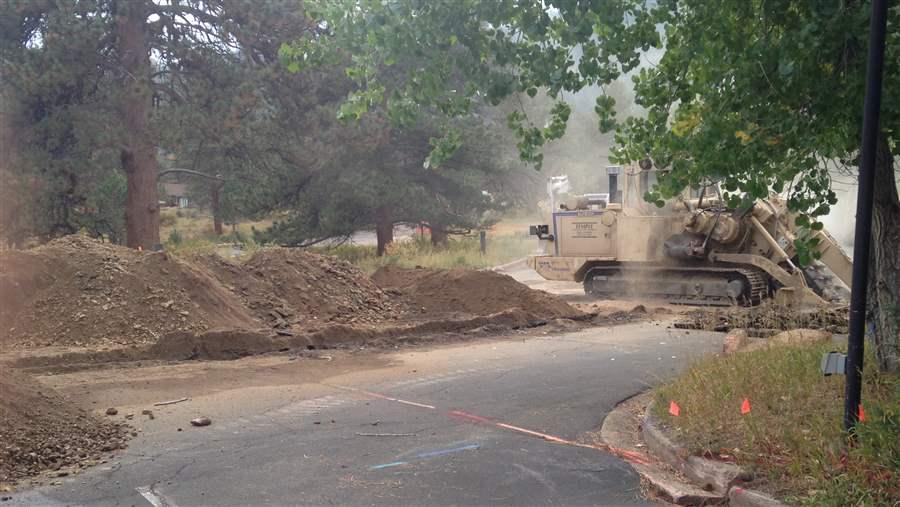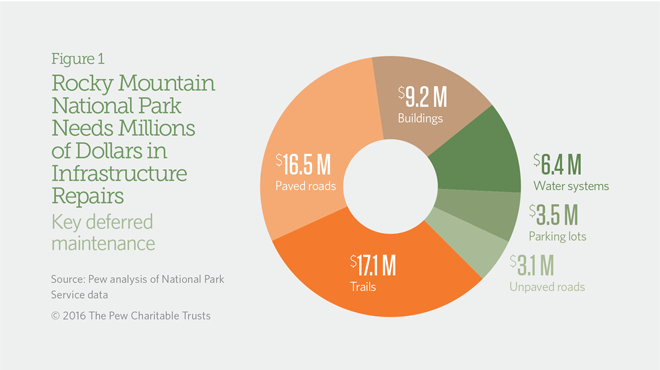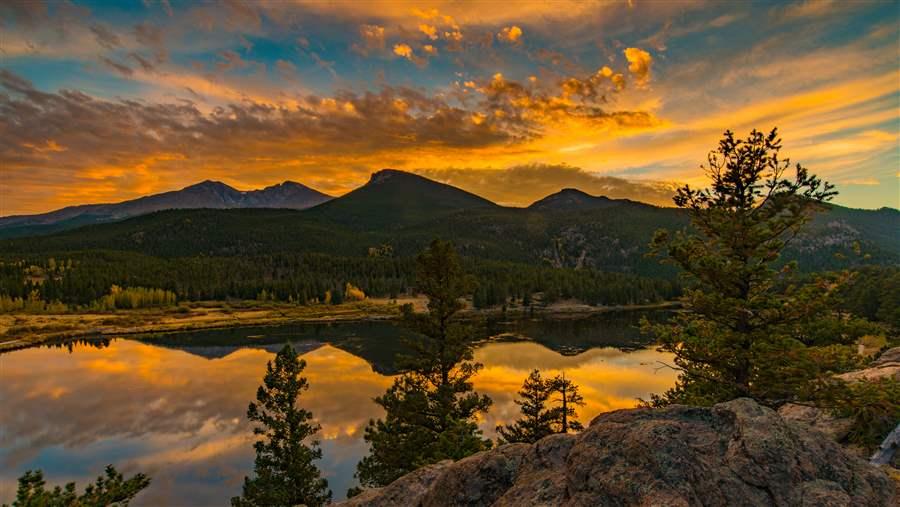Rocky Mountain National Park
Colorado
Pew created this case study using National Park Service deferred maintenance data issued in fiscal year 2015. The information listed here may no longer reflect the NPS site’s current condition or maintenance requirements. To find the most up-to-date information, please use the National Park Repair Needs tool.
This case study was updated on July 31, 2017, to reflect newly released 2016 data and to correct references to calendar and fiscal year.
Rocky Mountain National Park needs $63 million worth of repairs to trails, water lines, and other infrastructure
Overview
Rocky Mountain National Park is one of the most visited parks in the United States. Last year, there were 4 million visits to its majestic peaks, which are carpeted with wildflowers in the summertime. The tallest is Longs Peak, at 14,259 feet—one of Colorado’s celebrated “fourteeners.”1 Longs’ surrounding peaks form part of the Continental Divide, where melting snow runs either west to the Pacific Ocean or east to the Atlantic.2 Encircled by these mountains is Estes Valley, home to thousands of elk and mule deer. All of these vistas are accessible via horseback riding, hiking, or driving, the most notable route being Trail Ridge Road, which is listed on the National Register of Historic Places. As it was being built in 1931, National Park Service Director Horace Albright said, “You will have the whole sweep of the Rockies before you in all directions.”3 Today, more than 300 miles of trails cut through the 415-square-mile park, but many are in disrepair due to a backlog of deferred maintenance.

The replacement of water lines is a top priority at the Beaver Meadows Visitor Center and park headquarters.
© Yaron Miller
Maintenance challenges
As visitors make their way from the gateway community of Estes Park to the interior of Rocky Mountain National Park, many stop at the Beaver Meadows Visitor Center to learn more about the park and shore up on provisions before motoring through or hiking along its peaks and valleys. Providing potable water for these visitors is a source of concern for park managers. The primary water system at the park’s headquarters, where the visitor center is located, has 50- to 70-year-old pipes that need to be replaced. To do so would cost nearly $5 million.
Most visitors drive through the park on Trail Ridge Road, the highest continuous paved road in the United States.4 Covering 48 miles between Estes Park on the park’s east side and Grand Lake on the west, it takes visitors through groves of aspen and pine and reaches its greatest elevation at 12,183 feet among alpine meadows.5 Upon its completion in 1941, the road was billed by the local newspaper Estes Park Trail as “the eighth wonder of the world.”6 But 70 years of continued use has left it with $7 million in necessary repairs, with another $4.5 million needed to fix Beaver Meadow Road, which feeds into this main artery.
Many visitors choose to hike some of the 300 miles of trails that the park is renowned for. Given the magnitude of the system, it’s not surprising that the trails need at least $17 million in repairs—accounting for more than a quarter of the park’s total deferred maintenance needs. Most of the wear and tear has resulted from high use of “social” trails: nonauthorized pathways created by visitors to circumvent official paths. A flood in 2013 also left trails in the Alluvial Fan and Old Fall River Road areas severely damaged or destroyed, and some of those remain closed to the public.7 The remoteness of the park’s interior makes refurbishment of these trails more costly.
“Visitors to Rocky Mountain National Park enjoy hiking trails that lead to some of the most beautiful vistas along the Continental Divide. Unfortunately, the park needs more than $17 million to fix them.” Charles Money, Executive Director, Rocky Mountain Conservancy
Recommendations
To address the infrastructure needs at Rocky Mountain and other National Park Service sites in Colorado and across the country, Congress should:
- Ensure that infrastructure initiatives include provisions to address park maintenance.
- Provide dedicated annual federal funding for national park repairs.
- Enact innovative policy reforms to ensure that deferred maintenance does not escalate.
- Provide more highway funding for NPS maintenance needs.
- Create more opportunities for public-private collaboration and donations to help restore park infrastructure.
Rocky Mountain National Park Facts
2016
|
Visitor spending |
$298.7 million |
|
Jobs created by visitor spending |
4,600 |
|
Economic output |
$455.8 million |
|
Labor income |
$169.2 million |
|
Visits |
4,517,585 |
|
Deferred maintenance (fiscal year 2015) |
$63 million |
Sources: National Park Service, “Annual Visitation Report by Years: 2006 to 2016,” accessed July 13, 2017, https://irma.nps.gov/Stats/ SSRSReports/National%20Reports/Annual%20Visitation%20By%20Park%20(1979%20-%20Last%20Calendar%20Year); National Park Service, “Visitor Spending Effects,” accessed July 13, 2017, https://www.nps.gov/subjects/socialscience/vse.htm; National Park Service, “NPS Deferred Maintenance Reports,” accessed Aug. 19, 2016, https://www.nps.gov/subjects/plandesignconstruct/defermain.htm © 2016 The Pew Charitable Trusts
© 2017 The Pew Charitable Trusts

The Pew Charitable Trusts works alongside the National Parks Conservation Association, the National Trust for Historic Preservation, and other national and local groups to ensure that our national park resources are maintained and protected for future generations to enjoy.
Endnotes
- National Park Service, “Longs Peak-Keyhole Route,” accessed Sept. 21, 2016, https://www.nps.gov/romo/planyourvisit/longspeak.htm.
- Colorado.com, “Colorado Scenic Byway: Trail Ridge Road—Rocky Mountain National Park,” accessed Sept. 21, 2016, http://www.colorado. com/articles/colorado-scenic-byway-trail-ridge-road-rocky-mountain-national-park.
- National Park Service, “Trail Ridge Road,” accessed Sept. 21, 2016, https://www.nps.gov/romo/planyourvisit/trail_ridge_road.htm.
- RockyMountainNationalPark.com, “Trail Ridge Road,” accessed Sept. 21, 2016, http://rockymountainnationalpark.com/trails-maps/trail- ridge-road.
- National Park Service, “Trail Ridge Road.”
- Timothy Davis, National Park Roads: A Legacy in the American Landscape (Charlottesville, Virginia: University of Virginia Press, 2016).
- National Park Service, “Flood Impacts and Closures,” accessed Sept. 21, 2016, https://www.nps.gov/romo/planyourvisit/flood-impacts- and-closures.htm.
















